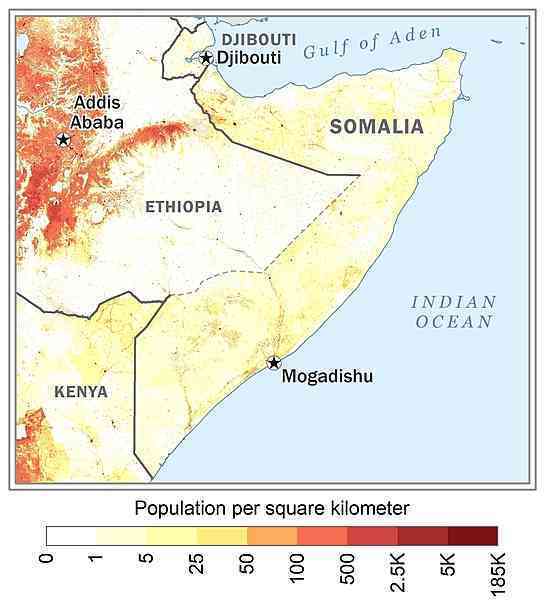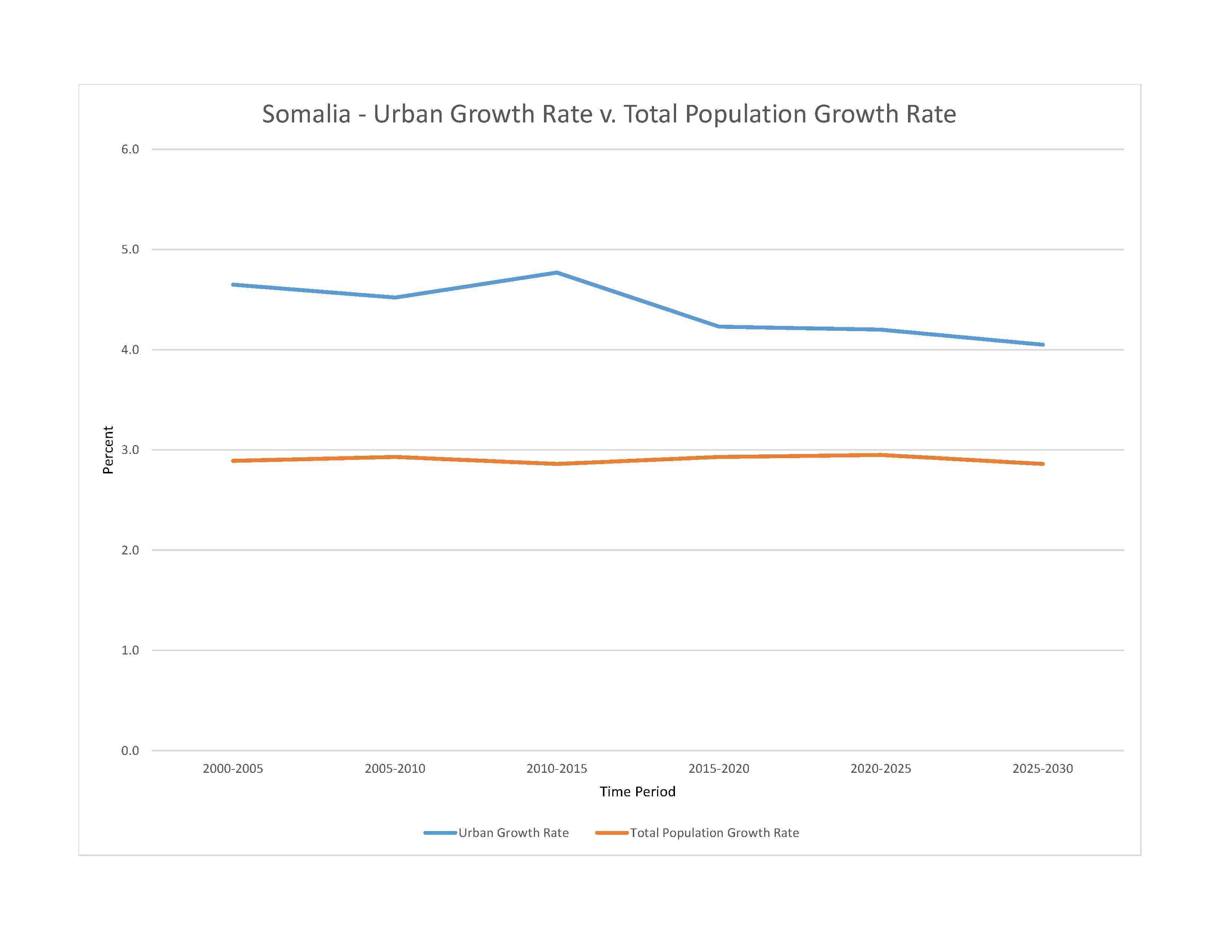
12,693,796 (2023 est.)
note: this estimate was derived from an official census taken in 1975 by the Somali Government; population counting in Somalia is complicated by the large number of nomads and by refugee movements in response to famine and clan warfare
noun: Somali(s)
adjective: Somali
Somali 85%, Bantu and other non-Somali 15% (including 30,000 Arabs)
Somali (official, according to the 2012 Transitional Federal Charter), Arabic (official, according to the 2012 Transitional Federal Charter), Italian, English
major-language sample(s):
Buugga Xaqiiqda Aduunka, waa laga maarmaanka macluumaadka assasiga. (Somali)
The World Factbook, the indispensable source for basic information.
Sunni Muslim (Islam) (official, according to the 2012 Transitional Federal Charter)
Somalia scores very low for most humanitarian indicators, suffering from poor governance, protracted internal conflict, underdevelopment, economic decline, poverty, social and gender inequality, and environmental degradation. Despite civil war and famine raising its mortality rate, Somalia’s high fertility rate and large proportion of people of reproductive age maintain rapid population growth, with each generation being larger than the prior one. More than 60% of Somalia’s population is younger than 25 as of 2020, and the fertility rate is among the world’s highest at almost 5.5 children per woman – a rate that has decreased little since the 1970s.
A lack of educational and job opportunities is a major source of tension for Somalia’s large youth cohort, making them vulnerable to recruitment by extremist and pirate groups. Somalia has one of the world’s lowest primary school enrollment rates – just over 40% of children are in school – and one of the world’s highest youth unemployment rates. Life expectancy is low as a result of high infant and maternal mortality rates, the spread of preventable diseases, poor sanitation, chronic malnutrition, and inadequate health services.
During the two decades of conflict that followed the fall of the SIAD regime in 1991, hundreds of thousands of Somalis fled their homes. Today Somalia is the world’s fourth highest source country for refugees, after Ukraine, Syria and Afghanistan. Insecurity, drought, floods, food shortages, and a lack of economic opportunities are the driving factors.
As of 2022, more than 660,000 Somali refugees were hosted in the region, mainly in Kenya, Yemen, Egypt, Ethiopia, Djibouti, and Uganda, while nearly 3 million Somalis were internally displaced. Since the implementation of a tripartite voluntary repatriation agreement among Kenya, Somalia, and the UNHCR in 2013, many Somali refugees have returned home, some 80,000 between 2014 and 2022. The Kenyan Government in March 2021 ordered the closure of its two largest refugee camps, Dadaab and Kakuma, which then hosted more than 410,000 mainly Somali refugees. However, the UN refugee agency presented a road map, including voluntary repatriation, relocation to third countries, and alternative stay options that persuaded the Kenyan Government to delay the closures. The plan was supposed to lead to both camps being closed by 30 June 2022. Yet, as of May 2022, few Somali refugees had decided to return home because of security concerns and the lack of job prospects, instead waiting in the camps unsure of what the future held for them. Other Somali asylum seekers brave the dangers of crossing the Gulf of Aden to reach Yemen – despite its internal conflict – with aspirations to move onward to Saudi Arabia and other locations.
0-14 years: 41.54% (male 2,633,262/female 2,640,088)
15-64 years: 55.77% (male 3,609,721/female 3,469,735)
65 years and over: 2.69% (2023 est.) (male 143,742/female 197,248)
total dependency ratio: 99.4
youth dependency ratio: 94.2
elderly dependency ratio: 5.2
potential support ratio: 19.3 (2021 est.)
total: 19 years (2023 est.)
male: 19.2 years
female: 18.7 years
2.49% (2023 est.)
37.7 births/1,000 population (2023 est.)
11.4 deaths/1,000 population (2023 est.)
-1.4 migrant(s)/1,000 population (2023 est.)
distribution varies greatly throughout the country; least densely populated areas are in the northeast and central regions, as well as areas along the Kenyan border; most populated areas are in and around the cities of Mogadishu, Marka, Boorama, Hargeysa, and Baidoa as shown on this 
urban population: 47.9% of total population (2023)
rate of urbanization: 4.2% annual rate of change (2020-25 est.)

2.610 million MOGADISHU (capital), 1.127 million Hargeysa (2023)
at birth: 1.03 male(s)/female
0-14 years: 1 male(s)/female
15-64 years: 1.04 male(s)/female
65 years and over: 0.73 male(s)/female
total population: 1.01 male(s)/female (2023 est.)
621 deaths/100,000 live births (2020 est.)
total: 85.1 deaths/1,000 live births (2023 est.)
male: 94.7 deaths/1,000 live births
female: 75.2 deaths/1,000 live births
total population: 56.1 years (2023 est.)
male: 53.8 years
female: 58.6 years
5.22 children born/woman (2023 est.)
2.57 (2023 est.)
6.9% (2018/19)
improved: urban: 96.4% of population
rural: 73.7% of population
total: 84.2% of population
unimproved: urban: 3.6% of population
rural: 26.3% of population
total: 15.8% of population (2020 est.)
N/A
0.02 physicians/1,000 population (2014)
0.9 beds/1,000 population (2017)
improved: urban: 82.4% of population
rural: 33.8% of population
total: 56.2% of population
unimproved: urban: 17.6% of population
rural: 66.2% of population
total: 43.8% of population (2020 est.)
degree of risk: very high (2023)
food or waterborne diseases: bacterial and protozoal diarrhea, hepatitis A and E, and typhoid fever
vectorborne diseases: dengue fever, malaria, Rift Valley fever, and sexually transmitted diseases: hepatitis B (2024)
water contact diseases: schistosomiasis
animal contact diseases: rabies
note: on 31 August 2023, the US Centers for Disease Control and Prevention (CDC) issued a Travel Alert for polio in Africa; Somalia is currently considered a high risk to travelers for circulating vaccine-derived polioviruses (cVDPV); vaccine-derived poliovirus (VDPV) is a strain of the weakened poliovirus that was initially included in oral polio vaccine (OPV) and that has changed over time and behaves more like the wild or naturally occurring virus; this means it can be spread more easily to people who are unvaccinated against polio and who come in contact with the stool or respiratory secretions, such as from a sneeze, of an “infected” person who received oral polio vaccine; the CDC recommends that before any international travel, anyone unvaccinated, incompletely vaccinated, or with an unknown polio vaccination status should complete the routine polio vaccine series; before travel to any high-risk destination, the CDC recommends that adults who previously completed the full, routine polio vaccine series receive a single, lifetime booster dose of polio vaccine
8.3% (2016)
total: 0 liters of pure alcohol (2019 est.)
beer: 0 liters of pure alcohol (2019 est.)
wine: 0 liters of pure alcohol (2019 est.)
spirits: 0 liters of pure alcohol (2019 est.)
other alcohols: 0 liters of pure alcohol (2019 est.)
62.9% (2023 est.)
women married by age 15: 16.8%
women married by age 18: 35.5%
men married by age 18: 5.6% (2020 est.)
0.3% of GDP (2019) NA
total population: NA
male: NA
female: NA
NOTE: The information regarding Somalia on this page is re-published from the 2024 World Fact Book of the United States Central Intelligence Agency and other sources. No claims are made regarding the accuracy of Somalia 2024 information contained here. All suggestions for corrections of any errors about Somalia 2024 should be addressed to the CIA or the source cited on each page.
This page was last modified 04 May 24, Copyright © 2024 ITA all rights reserved.